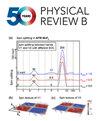压力诱导的金属极性畸变增强及其对Rashba自旋分裂的影响
IF 3.7
2区 物理与天体物理
Q1 Physics and Astronomy
引用次数: 0
摘要
极性金属是一类有趣的材料,具有极性晶体结构,同时也表现出金属导电性。极性金属的独特性质挑战了人们的预期,为探索非常规磁性、超铁电多铁性等奇异现象铺平了道路,并为开发多功能设备铺平了道路,这些设备可以利用材料的极性结构和自旋电导率的不对称性,这是由于Rashba效应引起的。在这里,通过高压单晶衍射研究,我们报告了这种金属Ca3Ru2O7的压力诱导的极性畸变增强。我们的密度泛函理论计算强调,关于极性畸变幅度和Rashba自旋分裂幅度之间的线性依赖关系的天真假设可能并不普遍有效。2025年由美国物理学会出版本文章由计算机程序翻译,如有差异,请以英文原文为准。
Pressure-induced enhancement of polar distortions in a metal and implications for the Rashba spin splitting
Polar metals are an intriguing class of materials that feature a polar crystal structure while also exhibiting metallic conductivity. The unique properties of polar metals challenge expectations, making way for the exploration of exotic phenomena such as unconventional magnetism, hyperferroelectric multiferroicity, and the development of multifunctional devices that can leverage both the material's polar structure and its asymmetry in the spin conductivity, that arises due to the Rashba effect. Here, via a high-pressure single-crystal diffraction study, we report the pressure-induced enhancement of polar distortions in such a metal, Ca3Ru2O7. Our density functional theory calculations highlight that naive assumptions about the linear dependency between polar distortion amplitudes and the magnitude of the Rashba spin splitting may not be generally valid. Published by the American Physical Society 2025
求助全文
通过发布文献求助,成功后即可免费获取论文全文。
去求助
来源期刊

Physical Review B
物理-物理:凝聚态物理
CiteScore
6.70
自引率
32.40%
发文量
0
审稿时长
3.0 months
期刊介绍:
Physical Review B (PRB) is the world’s largest dedicated physics journal, publishing approximately 100 new, high-quality papers each week. The most highly cited journal in condensed matter physics, PRB provides outstanding depth and breadth of coverage, combined with unrivaled context and background for ongoing research by scientists worldwide.
PRB covers the full range of condensed matter, materials physics, and related subfields, including:
-Structure and phase transitions
-Ferroelectrics and multiferroics
-Disordered systems and alloys
-Magnetism
-Superconductivity
-Electronic structure, photonics, and metamaterials
-Semiconductors and mesoscopic systems
-Surfaces, nanoscience, and two-dimensional materials
-Topological states of matter
 求助内容:
求助内容: 应助结果提醒方式:
应助结果提醒方式:


